In traditional landscape photography (or cityscape or seascape), photographers combine wide angle lenses with small apertures to achieve sharpness throughout an entire scene from the foreground to the background. This is in direct contrast to, say, portrait photography where the background is intentionally blurred. When looking at a photograph, the eye naturally goes to foreground elements and wants to rest on whatever is in focus. That works out perfectly for portraits where you usually want the focus on the eyes of your subject. The blurred background and in-focus foreground are strong compositional elements that focus attention where you want it. But in a photograph with everything in focus, you can’t rely on a single focus point to hold the viewer’s attention.
… Continue reading Learning composition: foreground, middleground, background

 The Bogen Super Clamp (
The Bogen Super Clamp (






